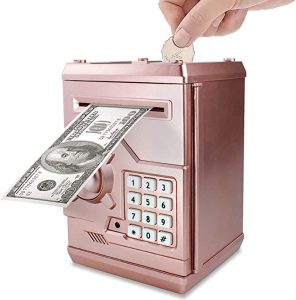The Best Kids’ Safe

Our Review Process
Don't Waste Your Money is focused on helping you make the best purchasing decision. Our team of experts spends hundreds of hours analyzing, testing, and researching products so you don't have to. Learn more.
Our Picks For The Top Kids' Safes
- 1. Totola Deco Password Protection Mini Kids’ Safe
- 2. Like Classic Bill Feeder Kids’ Safe
- 3. Yoego Electronic Auto-Scrolling Kids’ Safe
- 4. Setibre High-Capacity Password-Protected Kids’ Safe
- 5. Suliper Cashpoint Machine Kids’ Safe
- 6. Zonkin Multi-Use Passcode-Secure Kids’ Safe
- 7. Refasy Banknote & Coin Password-Protected Kids’ Safe
Featuring a creative design that looks like an ATM, this kids' safe has you enter a code to access your money. You'll find separate coin and bill slots along with a knob to open the container. You can choose from eight colors.
Fun FeaturesConsider this option if you'd like a unique bank that takes a security code and offers plenty of space and versatility.
This kids' safe is designed to resemble a bank vault. What makes it stand out from other options on the market is that it offers two levels of security. First, the user must put in his or her passcode. Second, a thumbprint is required for access to the bank's contents.
Great GiftAll you need are three AA batteries to use this kids' safe.
Made from sturdy ABS plastic, this kids' safe is built to last. It’s big enough to store 600 coins or 100 paper bills to help children learn the value of saving money. The functional combination lock comes with a default password that children can easily change to something they will remember.
Cool PatternsAvailable in a variety of fun patterns and bright solid colors, this safe will be the perfect fit for any children’s bedroom or playroom.
A slot with a scroll lets children insert bills into the safe as though sliding them into an ATM machine. Premium ABS plastic ensures it will hold up through many uses, while also keeping the design environmentally safe. It comes with a combination that lets you choose four digits to customize the passcode.
Fun To UseThere are two ways to insert bills into this kids' safe: open the door and set them inside or pass them through the slot.
Buying Guide
By learning how to save their allowance, gift money and other earnings from an early age, children can head into adulthood with a foundation that will help them avoid the stress that can come with financial illiteracy.
Today, there are many age-appropriate tools available to help children learn to manage money. Those include prepaid debit cards and apps, but some financial experts emphasize that emotionally, having funds in old-fashioned cash form is the best way for anyone to learn to manage money. There are many ways to approach teaching cash-based financial skills, including the classic piggy bank and the envelope system.
But there’s a newer option that parents might not know about: Kid-targeted safes that offer a new twist on the piggy bank. They keep money secure and accessible only through a passcode. These newer safes also have a slot for bills, as well as one for coins. The larger capacity means children can save hundreds of dollars before running out of room, allowing them to save up for a serious reward.
If you’re going for a kid-friendly safe, one of the best features on newer versions is an electronic scroll that pulls bills in. This operates similar to placing cash into the slot of an ATM or vending machine and can be very gratifying. Some safes even build in music as a reward for inserting bills.
Most kids’ safes come with a four-digit password that parents can reset. You can decide whether or not your child knows the passcode. Older children might choose to set the password themselves and keep it top secret, adding another level of independence to the whole thing. When the password is input correctly, the safe lights up and the knob becomes maneuverable, which also can be a gratifying experience to a child who has worked hard to save.
One downside to kid-friendly safes versus traditional piggy banks is that they tend to be larger. You’ll need a place to store the safe, whether it’s in a closet, on a shelf or elsewhere.
What to Look For
- Safes for children aren’t usually ready to use right out of the box. A parent will likely need to set up the password, which will require following instructions. These instructions should be included in the box but if not, you should be able to find them online.
- Kid-friendly safes are typically made from a thick, durable plastic like ABS. Although these safes are built to last, they’re also typically fairly tamperproof. The locking mechanism can be broken with determination, though, so keep that in mind.
- Unlike typical safes, kid-friendly safes often aren’t fireproof or waterproof.
- The slot in the door of a child’s safe is designed specifically for paper currency. If coins will be involved, make sure there’s a slot for those, as well. This would typically found on the top of the safe.
- If environmental friendliness is a concern, look for a safe built by a company that uses sustainable manufacturing in developing.
- Some safes have lighting on the keypad. This can be especially beneficial if you’re storing the safe in a dark place like a closet.
- Most of these safes are battery-powered, so you’ll need to make sure you have spares on hand for when they run out. You won’t be able to open the safe if the batteries are dead.
- Since the experience of inserting bills is so gratifying, consider getting change in small bills when you’re out and about. You could trade your ones for a child’s five or twenty to extend the fun of depositing bills.
More to Explore
Piggy banks may be associated with kids these days, but they didn’t start that way. The name itself has an interesting origin story. Before financial institutions were around, households kept their cash in the house, often in kitchen jars. Those jars were commonly made from an orange-colored clay called pygg, which is what led these home-based banks to earn the name “pygg pot.”
As these household jars evolved over the years, the “pygg” title evolved with it. When potters began making specialized pots for storing coins, they often formed them in the shape of pigs, and the association with the type of clay was quickly forgotten. Early piggy banks didn’t have a way to remove the money without breaking the entire jar, creating an ongoing demand for replacements.

















